Diving in La Paz is a popular activity, drawing in visitors from far and wide to experience the amazing marine fauna of the Sea of Cortez.
If you are mulling over where to take your next dive trip, then look no further than diving in La Paz, Mexico, a coastal city that provides a great base for your dive adventure in the Sea of Cortez.
Inspired by the species diversity and abundance of the Sea of Cortez, Jacques-Yves Cousteau dubbed it “The World’s Aquarium” shortly after he started diving here in the 1950’s.
Originally called the Gulf of California, the Sea of Cortez crept into existence around five million years ago when tectonic activity gradually tore the Baja Peninsula away from mainland Mexico resulting in the creation of a unique sea and assemblage of marine organisms.
The Sea of Cortez is widely considered to be one of world’s most biologically-rich bodies of water, providing habitat to almost one thousand species of fish as well as numerous species of whales, dolphins, sharks, rays, sea turtles, and seals.
Follows is a guide to some of the most popular dive sites in La Paz.
La Paz Dive Sites
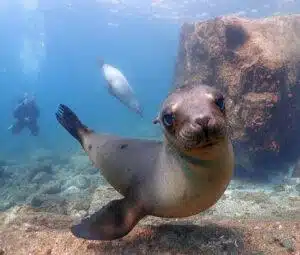 Los Islotes
Los Islotes
This pair of rocky islets form the northern-most point of the land component of the Espiritu Santo National Park and is one of three no fishing zones within the Park. Los Islotes is famous for its huge population of California sea lions (Zalophus californianus). The last government census conducted over the summer of 2021 identified 853 individuals. Playful juveniles often interact with divers and snorkelers making it one of the most popular sites for divers in La Paz.
Maximum depth ~ 18 m / 60′
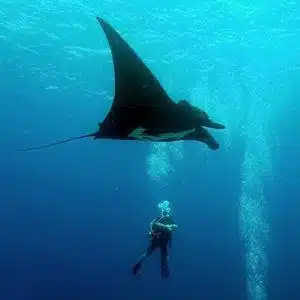 La Reina
La Reina
La Reina is a small islet located off the northern-point of Isla Cerralvo, AKA Jacques Cousteau Island. A small number of California sea lions have taken refuge here which is not surprising due to the biological richness of the site.
La Reina boasts some interesting rock formations including a submarine canyon whose vertical surfaces are carpeted in sea fans and colourful colonies of sponges.
When diving at La Reina there is the possibility of encountering oceanic giant manta rays (Mobula biostris) from July to October.
Maximum depth ~ 24 m / 80′
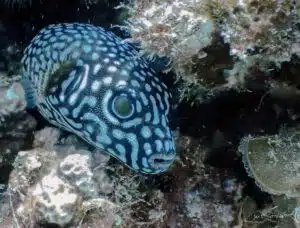 El Bajo
El Bajo
El Bajo consists of three seamounts located within the Espiritu Santo National Park around 30 minutes boat ride from Los Islotes. Divers come from all over the world for the possibility of observing pelagic sharks including the scalloped hammerhead (Sphyrna lewini) and the silky shark (Carcharhinus falciformis). Even in the absence of sharks, El Bajo is a superb dive site abundant with marine life. You’d be hard-pushed to find a site with so many moray eels!
Maximum depth ~ 40 m / 130′
Swanne Rock
This submerged rock is located in the San Lorenzo Channel between La Paz and Espiritu Santo island. It is another hangout for the California sea lion most likely due to the abundance of prey items for them. The rock’s summit lays just below the surface making it great for snorkeling as well. Large schools of fish, including spotted-tailed grunts and Mexican goatfish, can be regularly observed here.
Maximum depth ~ 12 m / 40′
El Salvatierra (shipwreck)
The Salvatierra began its life in Chesapeake Bay serving in WWII as a ferry. Sometime after the war had ended, the ship was bought at an auction and brought through the Panama Channel to serve as a ferry between La Paz and Mazatlan.
In 1976 the Salvatierra met with Swanne Rock tearing open her hull and causing her to sink. The same year, Hurricane Lisa hit La Paz, tearing the decking from the Salvatierra and scattering her cargo of trucks across the sea floor making for an interesting dive site that habours much marine life including huge groupers and schooling fish.
Maximum depth ~ 20 m / 65′
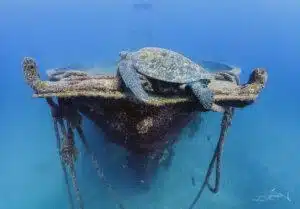 Fang Ming (shipwreck)
Fang Ming (shipwreck)
The Fang Ming is a shipwreck of Chinese origin. In her last days she served to smuggle illegal immigrants from China to the United States. Consequently, in 1995, she was caught in the act and seized by Mexican authorities. In 1999 the Fang Ming became the first intentionally sunken ship for the purpose of creating an artificial reef in all of Latin America.
Today, the Fang Ming is abundant with marine life and has become for an important habitat for sea turtles, mainly the green sea turtle (Chelonia mydas) that come here to rest and be cleaned.
Maximum depth ~ 20 m / 65′
For prices for diving click here.
For dive courses click here.
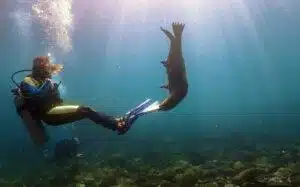 One of the most fun and exciting places to dive in La Paz is at Los Islotes, a pair of islets located at the northern-tip of the Espiritu Santo National Park. This rock formation is located approximately 1:30 hrs from La Paz by boat and is home to a large colony of 850 + California sea lions (Zalophus californianus). These animals are popularly known as the pups of the sea, due to the curious and playful nature of the juveniles. On land, these animals may appear a little clumsy, but under the water, they are agile, graceful swimmers. Reaching speeds of up to 20 miles per hour, the sea lions will amaze you with their energy and maneuverability.
One of the most fun and exciting places to dive in La Paz is at Los Islotes, a pair of islets located at the northern-tip of the Espiritu Santo National Park. This rock formation is located approximately 1:30 hrs from La Paz by boat and is home to a large colony of 850 + California sea lions (Zalophus californianus). These animals are popularly known as the pups of the sea, due to the curious and playful nature of the juveniles. On land, these animals may appear a little clumsy, but under the water, they are agile, graceful swimmers. Reaching speeds of up to 20 miles per hour, the sea lions will amaze you with their energy and maneuverability. Sea lions are very vocal animals and will often seemingly argue with each other for hours as they negotiate for space to haul out on the rocks and bask in the sun.
Sea lions are very vocal animals and will often seemingly argue with each other for hours as they negotiate for space to haul out on the rocks and bask in the sun. The season for swimming and diving in La Paz with sea lions is from September to the end of May each year, since the breeding season of the sea lions starts in June and ends in August so in-water interactions are suspended for this critical time for the species.
The season for swimming and diving in La Paz with sea lions is from September to the end of May each year, since the breeding season of the sea lions starts in June and ends in August so in-water interactions are suspended for this critical time for the species.
 La Reina
La Reina El Bajo
El Bajo Fang Ming (shipwreck)
Fang Ming (shipwreck)